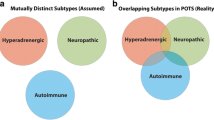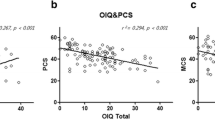Abstract
Central nervous system dysfunction with myalgic encephalomyelitis (ME) has been suggested as the main cause of chronic fatigue syndrome. Fluctuation of the symptom severity and hierarchy is a characteristic feature in ME patients. The characteristics of the sympathetic activation may differ between the “good days” and “bad days” in them. Twenty-four ME patients with orthostatic intolerance underwent a conventional 10-min active standing test and echocardiography both on a “good day” and a “bad day”, defined according to the severity of their symptoms. The mean heart rate at rest was significantly higher on the “bad days” than on the “good days”. During the standing test on a “bad day”, 5 patients (21 %) failed to maintain an upright posture for 10 min, whereas on a “good day” all the 24 patients maintained it. Postural orthostatic tachycardia (POT) (increase in heart rate ≥30 beats/min) or severe POT (heart rate ≥120 beats/min) was observed on the “bad days” in 10 patients (43 %) who did not suffer from the severe tachycardia on the “good days”, suggesting the exaggerated sympathetic nervous activation. In contrast, POT did not occur or severe POT was attenuated on the “bad days” in 5 patients (21 %) who developed POT or severe POT on the “good days”, suggesting the impaired sympathetic activation. Echocardiography revealed significantly lower mean values of both the left ventricular end-diastolic diameter and stroke volume index on the “bad days” compared with the “good days”. In conclusion, in ME patients with orthostatic intolerance, the exaggerated activation of the sympathetic nervous system while standing appears to switch to the impaired sympathetic activation after the system is loaded with the additional accentuated stimuli associated with the preload reduction.


Similar content being viewed by others
References
Shafran SD (1991) The chronic fatigue syndrome. Am J Med 90:730–739
Fukuda K, Straus SE, Hickle I, Sharpe MC, Dobbins JG, Komaroff A (1994) International chronic fatigue syndrome study group. The chronic fatigue syndrome: a comprehensive approach to its definition and study. Ann Int Med 121:953–959
Afari N, Buchwald D (2003) Chronic fatigue syndrome: a review. Am J Psychiatry 160:221–236
Carruthers BM, van de Sande MI, DeMeirleir KL, Klimas NG, Broderick G, Mitchell T, Staines D, Powles ACP, Speight N, Vallings R, Bateman L, Baumgarten-Austrheim B, Bell DS, Carlo-Stella N, Chia J, Darragh A, Jo D, Lewis D, Light AR, Marshall-Gradisbik S, Mena I, Mikovits JA, Miwa K, Murovska M, Pall ML, Stevens S (2011) Myalgic encephalomyelitis: international consensus criteria. J Int Med 270:327–338
Schondorf R, Freeman R (1999) The importance of orthostatic intolerance in the chronic fatigue syndrome. Am J Med Sci 317:117–123
Schondorf R, Benoit J, Wein T, Phaneuf D (1999) Orthostatic intolerance in the chronic fatigue syndrome. J Auton Nerv Syst 75:192–201
Streeten DHP, Thomas D, Bell DS (2000) The roles of orthostatic hypotension, orthostatic tachycardia, and subnormal erythrocyte volume in the pathogenesis of the chronic fatigue syndrome. Am J Med Sci 320:1–8
Miwa K, Fujita M (2011) Small heart with low cardiac output for orthostatic intolerance in patients with chronic fatigue syndrome. Clin Cardiol 34:782–786
Miwa K (2015) Cardiac dysfunction and orthostatic intolerance in patients with myalgic encephalomyelitis and a small left ventricle. Heart Vessels 30:484–489. doi:10.1007/s00380-014-0510-y
Furlan R, Jacob G, Snell M, Robertson D, Porta A, Harris P, Mosqueda-Garcia R (1998) Chronic orthostatic intolerance: a disorder with discordant cardiac and vascular sympathetic control. Circulation 98:2154–2159
Stewart J (2002) Pooling in chronic orthostatic intolerance. Arterial vasoconstrictive but not venous compliance defects. Circulation 105:2274–2281
Stewart J (2004) Chronic orthostatic intolerance and the postural tachycardia syndrome (POTS). J Pediatr 145:725–730
Costigan A, Elliott C, McDonaldo C, Newton JL (2010) Orthostatic symptoms predict functional capacity in chronic fatigue syndrome: implications for management. QJM 103:589–595
Fu Q, VanGundy TB, Galbreath M, Shibata S, Jain M, Hastings JL, Bhella PS, Levine BD (2010) Cardiac origins of the postural orthostatic tachycardia syndrome. J Am Coll Cardiol 55:2858–2868
Schiller NB, Shah PM, Crawford M, DeMaria A, Devereux R, Feigenbaum H, Gutgeseaell H, Reichek N, Sahn D, Schnittinger I, Silverman N, Tajik J, the American Society of Echocardiography, Committee on Standards, Subcommittee on Quantification of Two-Dimensional Echocardiograms (1989) Recommendations for the quantification of the left ventricle by two-dimensional echocardiography. J Am Soc Echocardiogr 2:358–367
Teichholz LE, Kreulen T, Herman MV, Gorlin R (1976) Problems in echocardiographic volume determinations: echocardiographic–angiographic correlations in the presence or absence of asynergy. Am J Cardiol 37:7–11
Saito M, Mano T, Iwase S (1989) Sympathetic nerve activity related to local fatigue sensation during static contraction. J Appl Physiol 67:980–984
Pagani M, Lucini D (1999) Chronic fatigue syndrome: a hypothesis focusing on the autonomic nervous system. Clin Sci 96:117–125
Strobel G, Hack V, Kinscherf R, Weicher H (1993) Sustained noradrenaline sulphate response in long-distance runners and untrained subjects up to 2 h after exhausting exercise. Eur J Appl Physiol Occup Physiol 66:421–426
Freeman R, Komaroff AL (1997) Does the chronic fatigue syndrome involve the autonomic nervous system? Am J Med 102:357–364
Hurwitz BE, Coryell VT, Parker M, Martin P, LaPerriere A, Kilmas NG, Sfakianakis GN, Bilsker MS (2009) Chronic fatigue syndrome: illness severity, sedentary lifestyle, blood volume and evidence of diminished cardiac function. Clin Sci (Lond) 118:125–135
Miwa K, Fujita M (2008) “Small heart syndrome” in patients with chronic fatigue syndrome. Clin Cardiol 31:328–333
Miwa K, Fujita M (2009) Cardiac function fluctuates during exacerbation and remission in young adults with chronic fatigue syndrome and “small heart”. J Cardiol 54:29–35
Miwa K, Fujita M (2009) Cardiovascular dysfunction with low cardiac output due to small heart in patients with chronic fatigue syndrome. Inter Med 48:1849–1854
Raj SR, Biaggioni I, Yamhure PC, Black BK, Paranjape SY, Byrne DW, Robertson D (2005) Renin–aldosterone paradox and perturbed blood volume regulation underlying postural tachycardia syndrome. Circulation 111:1574–1582
Miwa K, Fujita M (2014) Renin–aldosterone paradox in patients with myalgic encephalomyelitis and orthostatic intolerance. Int J Cardiol 172:514–515
Tanaka H, Matsushima R, Tamai H, Kajimoto Y (2002) Impaired postural cerebral hemodynamics in young patients with chronic fatigue with and without orthostatic intolerance. J Pediatr 140:412–417
Peckerman A, Lamanca JJ, Dahl KA, Chemitiganti R, Qureishi B, Natelson BH (2003) Abnormal impedance cardiography predicts symptom severity in chronic fatigue syndrome. Am J Med Sci 326:55–60
Raj SR, Black BK, Biaggioni I, Paranjape SY, Ramirez M, Dupont WD, Robertson D (2009) Propranolol decreases tachycardia and improves symptoms in the postural tachycardia syndrome: less is more. Circulation 120:725–734
Ewan V, Norton M, Newton JL (2007) Symptom improvement in postural orthostatic tachycardia syndrome with the sinus node blocker ivabradine. Europace 9:1202
Kim BH, Cho KI, Kim SM, Kim N, Han J (2013) Heart rate reduction with ivabradine prevents thyroid hormone-induced cardiac remodeling in rat. Heart Vessels 28:524–535
Montague TJ, Marrie TJ, Klassen GA, Bewick DJ, Horacek BM (1989) Cardiac function at rest and with exercise in the chronic fatigue syndrome. Chest 95:779–784
Vanness JM, Snell CR, Strayer DR, Dempsey L IV, Stevens SR (2003) Subclassifying chronic fatigue syndrome through exercise testing. Med Sci Sports Exerc 35:908–913
Acknowledgments
I would like to thank Ms. Takako Miwa for her technical help. This work was supported in part by JSPS KAKENHI GRANT Number 15H00649.
Author information
Authors and Affiliations
Corresponding author
Ethics declarations
Conflict of interest
The author declares that there is no conflict of interest.
Ethical standard
This study is in compliance with the standards in the 1964 Declaration of Helsinki and its later amendments.
Rights and permissions
About this article
Cite this article
Miwa, K. Variability of postural orthostatic tachycardia in patients with myalgic encephalomyelitis and orthostatic intolerance. Heart Vessels 31, 1522–1528 (2016). https://doi.org/10.1007/s00380-015-0744-3
Received:
Accepted:
Published:
Issue Date:
DOI: https://doi.org/10.1007/s00380-015-0744-3




